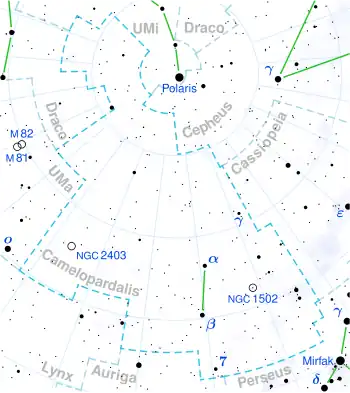 | |
| Observation data Epoch J2000.0 Equinox J2000.0 (ICRS) | |
|---|---|
| Constellation | Camelopardalis |
| Right ascension | 04h 36m 24.19802s[1] |
| Declination | +64° 15′ 41.7609″[1] |
| Apparent magnitude (V) | 5.91±0.01[2] |
| Characteristics | |
| Evolutionary stage | main sequence star[3] |
| Spectral type | A1 V[4] or A1 III[5] |
| U−B color index | −0.02[6] |
| B−V color index | −0.03[6] |
| Astrometry | |
| Radial velocity (Rv) | −22.6±1.8[7] km/s |
| Proper motion (μ) | RA: −25.398 mas/yr[1] Dec.: −8.119 mas/yr[1] |
| Parallax (π) | 6.6785 ± 0.0412 mas[1] |
| Distance | 488 ± 3 ly (149.7 ± 0.9 pc) |
| Absolute magnitude (MV) | +0.26[8] |
| Details | |
| Mass | 2.48±0.08[9] M☉ |
| Radius | 3.79+0.12 −0.13[10] R☉ |
| Luminosity | 101±2[1] L☉ |
| Surface gravity (log g) | 3.67+0.06 −0.08[10] cgs |
| Temperature | 9,616+134 −132[3] K |
| Metallicity [Fe/H] | −0.21[11] dex |
| Rotational velocity (v sin i) | 41.3±2.0[12] km/s |
| Age | 300+21 −19[9] Myr |
| Other designations | |
| Database references | |
| SIMBAD | data |
HD 28780, also known as HR 1440, is a solitary white-hued star[14] located in the northern circumpolar constellation Camelopardalis. It has an apparent magnitude of 5.91,[2] making it faintly viisble to the naked eye under ideal conditions. Gaia DR3 parallax measurements imply a distance of 488 light-years,[1] and it is currently drifting closer with a heliocentric radial velocity of −22.6 km/s.[7] At its current distance, HD 28780's brightness is diminished by 0.33 magnitudes due to interstellar extinction[15] and it has an absolute magnitude of +0.26.[8]
HD 28780 has a stellar classification of A1 V,[4] indicating that it is an ordinary A-type main-sequence star that is generating energy via hydrogen fusion at its core. However, Abt & Morell (1995) gave a classification of A1 III,[5] indicating that it is an evolved A-type giant star that has exhausted hydrogen fusion at its core. At the age of 300 million years,[9] HD 28780 has completed 80.2% of its main sequence lifetime.[3] It has 2.48 times the mass of the Sun[9] and a slightly enlarged radius 3.79 times larger than the Sun's.[10] The star radiates 101 times the luminosity of the Sun[1] from its photosphere at an effective temperature of 9,616 K.[3] HD 28780 is metal deficient with an iron abundance 61.7% that of the Sun's ([Fe/H] = −0.21)[11] and unlike most hot stars, it spins modestly with a projected rotational velocity of 41.3 km/s.[12]
References
- 1 2 3 4 5 6 7 8 Vallenari, A.; et al. (Gaia collaboration) (2023). "Gaia Data Release 3. Summary of the content and survey properties". Astronomy and Astrophysics. 674: A1. arXiv:2208.00211. Bibcode:2023A&A...674A...1G. doi:10.1051/0004-6361/202243940. S2CID 244398875. Gaia DR3 record for this source at VizieR.
- 1 2 Oja, T. (August 1991). "UBV photometry of stars whose positions are accurately known. VI". Astronomy and Astrophysics Supplement Series. 89: 415. Bibcode:1991A&AS...89..415O. ISSN 0365-0138.
- 1 2 3 4 Zorec, J.; Royer, F. (January 2012). "Rotational velocities of A-type stars IV: Evolution of rotational velocities". Astronomy & Astrophysics. 537: A120. arXiv:1201.2052. Bibcode:2012A&A...537A.120Z. doi:10.1051/0004-6361/201117691. eISSN 1432-0746. ISSN 0004-6361. S2CID 55586789.
- 1 2 Cowley, A.; Cowley, C.; Jaschek, M.; Jaschek, C. (April 1969). "A study of the bright stars. I. A catalogue of spectral classifications". The Astronomical Journal. 74: 375. Bibcode:1969AJ.....74..375C. doi:10.1086/110819. ISSN 0004-6256. S2CID 121555804.
- 1 2 Abt, Helmut A.; Morrell, Nidia I. (July 1995). "The Relation between Rotational Velocities and Spectral Peculiarities among A-Type Stars". The Astrophysical Journal Supplement Series. 99: 135. Bibcode:1995ApJS...99..135A. doi:10.1086/192182. ISSN 0067-0049. S2CID 120495962.
- 1 2 Oja, T. (April 1983). "UVB photometry of FK4 and FK4 Supplement stars". Astronomy and Astrophysics Supplement Series. 52: 131–134. Bibcode:1983A&AS...52..131O. ISSN 0365-0138.
- 1 2 Gontcharov, G. A. (November 2006). "Pulkovo Compilation of Radial Velocities for 35,495 Hipparcos stars in a common system". Astronomy Letters. 32 (11): 759–771. arXiv:1606.08053. Bibcode:2006AstL...32..759G. doi:10.1134/S1063773706110065. eISSN 1562-6873. ISSN 1063-7737. S2CID 119231169.
- 1 2 Anderson, E.; Francis, Ch. (May 2012). "XHIP: An extended hipparcos compilation". Astronomy Letters. 38 (5): 331–346. arXiv:1108.4971. Bibcode:2012AstL...38..331A. doi:10.1134/S1063773712050015. eISSN 1562-6873. ISSN 1063-7737. S2CID 119257644.
- 1 2 3 4 Grosbol, P. J. (June 1978). "Space velocities and ages of nearby early-type stars". Astronomy and Astrophysics Supplement Series. 32: 409–421. Bibcode:1978A&AS...32..409G. ISSN 0365-0138.
- 1 2 3 Stassun, Keivan G.; et al. (9 September 2019). "The Revised TESS Input Catalog and Candidate Target List". The Astronomical Journal. 158 (4): 138. arXiv:1905.10694. Bibcode:2019AJ....158..138S. doi:10.3847/1538-3881/ab3467. eISSN 1538-3881. hdl:1721.1/124721. S2CID 166227927.
- 1 2 Anders, F.; et al. (August 2019). "Photo-astrometric distances, extinctions, and astrophysical parameters for Gaia DR2 stars brighter than G = 18". Astronomy & Astrophysics. 628: A94. arXiv:1904.11302. Bibcode:2019A&A...628A..94A. doi:10.1051/0004-6361/201935765. eISSN 1432-0746. ISSN 0004-6361. S2CID 131780028.
- 1 2 Ramella, M.; Boehm, C.; Gerbaldi, M.; Faraggiana, R. (January 1989). ""Normal" main sequence A0 stars of low rotational velocity". Astronomy and Astrophysics. 209: 233–243. Bibcode:1989A&A...209..233R. ISSN 0004-6361.
- ↑ "HD 28780". SIMBAD. Centre de données astronomiques de Strasbourg. Retrieved July 20, 2023.
- ↑ Eggleton, P. P.; Tokovinin, A. A. (11 September 2008). "A catalogue of multiplicity among bright stellar systems". Monthly Notices of the Royal Astronomical Society. 389 (2): 869–879. arXiv:0806.2878. Bibcode:2008MNRAS.389..869E. doi:10.1111/j.1365-2966.2008.13596.x. eISSN 1365-2966. ISSN 0035-8711. S2CID 14878976.
- ↑ Gontcharov, George A.; Mosenkov, Aleksandr V. (28 September 2017). "Verifying reddening and extinction for Gaia DR1 TGAS main sequence stars". Monthly Notices of the Royal Astronomical Society. 472 (4): 3805–3820. arXiv:1709.01160. Bibcode:2017MNRAS.472.3805G. doi:10.1093/mnras/stx2219. eISSN 1365-2966. ISSN 0035-8711. S2CID 118879856.